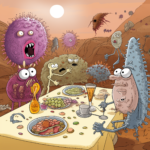In the sci-fi series Alien, the Xenomorophs have strong acid in their blood. Our recent research indicates that acid-blooded and Teflon-tissued aliens might be the predominant biochemistry in our galaxy. For these aliens water would be as toxic as sulfuric acid is to us.
We finally got the “Production and Reactions of Organic Molecules in Clouds of Venus” published. It models one possible pathway for how large organic molecules are produced in the clouds of Venus and proposes that other pathways might contribute to the organic carbon cycle, that I first proposed in 2021.
This paper was a surprise for astronomers and chemists alike, but what piques my interest is the implications for astrobiologists.
And so my imagination went wild when I realized that concentrated sulfuric acid is a suitable solvent for organic chemistry and can lead to faster production of complex organic molecules than the chemistry in water that gave life to us.
And so, here are some fun speculations, an inspiration for hard sci-fi, discussing how would life look like on planets where the predominant solvent is concentrated sulfuric acid.
First of all, the alien biochemistry would have to be build around more stable bonds. The standard CHNOPS (Carbon, Hydrogen, Nitrogen, Oxygen, Phosphorus, and Sulfur) would have to be complemented with fluorine and chlorine. While C-F or C-Cl bond is too stable in water and therefore not used in life as we know it, in hot concentrated sulfuric acid it would be perfect, providing much needed stability. Therefore, we can expect CHFONPSCl instead of CHNOPS.
Second, just like we preserve the conditions similar to the primordial pond in our cells, aliens evolved in sulfuric acid would have to keep the concentrated acid in their blood. Diluting this acid anywhere close to the range of our pH scale would kill them. These aliens must use Hammett acidity function to analyze their blood. Moisture is to these aliens more deadly than its absence is to us.
Now, we still do not know how common planets with sulfuric acid lakes and oceans on the surface are, as sulfuric acid reacts with bedrock minerals. But we have a model showing that planets where sulfuric acid is the predominant solvent – perhaps just in the clouds, like Venus, are more common than water worlds in our galaxy.
And so, when you meet aliens, be cautious about sharing bodily fluids with them. Good news is that they would get sick if they decide to eat you.




Hi Jan,
A very interesting article following on from your excellent paper “Production and Reactions of Organic Molecules in Clouds of Venus”. You are no doubt familiar with Januscz Petkovski’s recent publication showing how 19 of the 20 proteinogenic amino acids are stable in solutions of concentrated (75 to 98%) sulphuric acid. Only tryptophan is destroyed, as a result of the acidolysis reactions of the pyrrole subunit of the indole ring, so xenomorophs would need to use an alternative amino acid, possibly a quinolinyl-alanine, instead. However, the peptide bonds which hold amino acids together in proteins in ambient aqueous environments, would be unstable in concentrated acid, which is why we use 6M HCl under reflux for 16 hours, in order hydrolyse peptides and proteins into their constituent amino acids (and we do a parallel hydrolysis with 6M NaOH in order to reveal the number of tryptophan residues). Likewise, the ribose and deoxyribose-phosphate backbones which hold nucleic acids together, would also be very unstable in such concentrated acidic environments. The nucleobases, cytosine and adenine would also undergo acidolysis to yield uracil and inosine respectively. Alternative scaffolds would therefore be needed for the xenomorophs’ proteins and nucleic acids, and the latter will need alternative nucleobases.
While C-F bonds in perfluoroalkanes, which are resistant to nucleophilic attack, would be ideal in concentrated acidic environments, alkyl (but not aryl C-Cl) C-Cl bonds are susceptible to nucleophilic attack, in particular at elevated pH (>7), but this won’t be a problem in concentrated acid.
Best wishes, and let’s keep using our imaginations, and chemistry skills, to propose what sort of biopolymers would be used by the acidophilic xenomorophs!